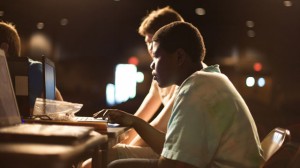Alisca Harris, a fourth-grade teacher at Craighead Elementary in Mobile, Alabama, has had to try different tactics before finding what sticks. Craighead has a predominantly African-American population and 95 percent of its students are eligible for free and reduced lunch. Harris has been steadily trying to integrate devices into her teaching practice, while being aware that kids and their families have different comfort levels with technology.
Parents were receptive to letting their children bring tablets from home, but don’t always understand the nature of the digital work. “Parents just wanted to see it in black and white,” Harris said, "because some of my students are being raised by grandparents and they really didn't know what these digital assignments were.” Some grandparents didn't believe their students were doing their reading on their devices. To strike a balance, Harris does paper and pencil creative projects, along with digital ones. She also sends all information home in various formats so everyone feels informed.
Harris has found that student-owned tablets -- cell phones aren't allowed by the district in elementary school -- are most helpful for increasing engagement, allowing students opportunities for creative expression and for giving her more information about when students understand a concept and when they’re struggling. Even though she teaches fourth grade, some students are reading at a second-grade level, while others are charging ahead to seventh-grade content. The devices help bridge the broad gap.
“[Students] can use the device to do research, they can move at their own pace, they’re not waiting on the slower ones,” Harris said.
Harris’ school uses an adaptive software called Stride Academy for reading, math and science. “They all like the sounds and animation,” Harris said. “They loved that because it was customized to them, no one else knew what they were doing.” Harris receives weekly updates on each student’s progress in the program, including whether they're just guessing, have clearly not understood concepts or if they're surpassing expectations. She can tailor her instruction to provide support to students who struggle and help the advanced students continue to challenge themselves.
For example, a few of Harris’ fourth graders leveled up to reading Harry Potter. To those who wanted to remember each of the plot twists and turns, Harris showed them how to use sticky note apps to keep notes. And though they could follow most of the story, there were often vocabulary words that they had trouble with. “It brought on a lot of dialogue,” Harris said. Together Harris and her students would discuss the meaning of words in context and how it impacted their understanding of the plot and context.
“That’s a lot better than taking a fourth grade book because they’re in the fourth grade and not challenging themselves,” Harris said.
BLOCKING SITES
Still, the strict web filters favored by the school district in elementary schools have hindered those same precocious students from directing their own learning in many cases.
One day Harris noticed that a student was frowning at his screen. Thinking he was confused about a concept, she went over to help him. Instead, she found that he was frowning because the filter was blocking him from accessing a book he wanted to check out from the library. “He was trying to access his own books from the library and his personal library card number wouldn't work,” Harris said. “Only the school's would, and they’re only allowed to check out certain books."
Harris admits that sometimes a book will be banned based on a very cursory search of keywords, but she thinks it’s a fair price to pay to protect younger kids from seeing inappropriate content – things they’re just not ready for.
“It’s a good thing they have a very strong block,” Harris said. “I trust them, but then I have to keep in mind that they are fourth graders. They're children and they're going to try to do things and they’re going to get off task as any child would do.” She knows they've already caught onto the trick of switching screens when a teacher isn't looking.
Harris helped pioneer BYOD at her school, but she approves of the strict filters her school sets on the web, even though they can block her from useful sites. “Our children, the environment they’re in, it teaches them more than they should know at that age,” Harris said. Many of her students have older brothers and sisters who teach their younger siblings inappropriate language or ideas. For example, a new drug “spice” has become popular in the neighborhoods where her students live. One student wanted to look it up on the internet, but Harris worried photos and descriptions of the drug's effects on the body would be too much for him.
“If I was a high school teacher, I wouldn't use the devices for apps, I would only use it for clicking a response or to look up something on a specific topic,” Harris said.


